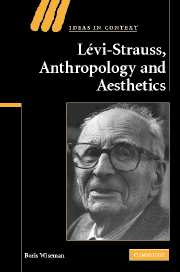Book contents
- Frontmatter
- Contents
- List of illustrations
- Acknowledgements
- Introduction: ethno-aesthetics
- 1 The reconciliation
- 2 Art and the logic of sensible qualities
- 3 The work of art as a system of signs
- 4 Structuralism, Symbolist poetics and abstract art
- 5 The anthropologist as art critic
- 6 Nature, culture, chance
- 7 From myth to music
- 8 Lévi-Strauss's mytho-poem
- Conclusion: between concept and metaphor
- References
- Index
- IDEAS IN CONTEXT
3 - The work of art as a system of signs
Published online by Cambridge University Press: 27 October 2009
- Frontmatter
- Contents
- List of illustrations
- Acknowledgements
- Introduction: ethno-aesthetics
- 1 The reconciliation
- 2 Art and the logic of sensible qualities
- 3 The work of art as a system of signs
- 4 Structuralism, Symbolist poetics and abstract art
- 5 The anthropologist as art critic
- 6 Nature, culture, chance
- 7 From myth to music
- 8 Lévi-Strauss's mytho-poem
- Conclusion: between concept and metaphor
- References
- Index
- IDEAS IN CONTEXT
Summary
In the previous chapter, I began by bringing to light the genealogical argument, implicit in The Savage Mind, that presents art as one among several ‘descendants’ of a ‘wild’ mode of thought whose origins may be traced to the Neolithic and beyond. I went on to argue that in theorising the mode of symbolisation specific to this ‘wild’ mode of thought – rooted in what he calls ‘concrete logic’ or ‘logic of sensible qualities’ – Lévi-Strauss provides an original solution to a question that lies at the core of philosophical aesthetics, that of the relation between conceptual–abstract thinking and sensory perception. Lévi-Strauss unites the subjective and objective dimensions of experience in a logic of sensory qualities and places this logic at the heart of what makes us, as social animals, producers of symbolic systems. In this chapter, I will turn to the question of what this logic of sensible qualities may teach us about aesthetic signs. What are the implications of Lévi-Strauss's imbrication of sense perception and logic for an aesthetic theory of signification? Beyond some of the popular misconceptions about structuralist/semiotic theories of art, Lévi-Strauss's works still contain untapped insights. I should state, from the outset, that to speak of ‘aesthetic signs’ is a short-hand and an artifice. In art, contrary to linguistics, there is no objective method for identifying so-called minimal units of signification.
- Type
- Chapter
- Information
- Levi-Strauss, Anthropology, and Aesthetics , pp. 80 - 99Publisher: Cambridge University PressPrint publication year: 2007



